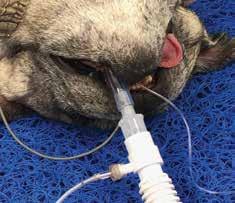
4 minute read
I Am Afraid of Anesthesia for My Pet Part II Sandra Waugh, VMD, MS
I Am Afraid of Anesthesia for My Pet - PART II
Sandra L Waugh VMD, MS
Advertisement
In the first article I discussed what anesthesia is and the need for pain medications as anesthetics provide little pain relief by themselves. In this article I will go over some of the equipment we use to make anesthesia as safe as possible.
Let’s take a broader view of this process. Miley, one of our clinic cats, is clearly not intimidated by all of the equipment! She likes the dental tables because there is a circulating warm water pad underneath her and it is turned on so it is warm when our patient arrives. Cats love warm spots!
In the first article I mentioned giving a pre-anesthetic dose of a narcotic and a small amount of a tranquilizer. These drugs make the pet somewhat sleepy and decrease their anxiety. An IV catheter is then placed in a vein, usually a front leg but sometimes a hind leg is used. The fur is clipped to allow us to clean the skin thoroughly. The IV catheter has multiple uses: to give the drugs that induce anesthesia, to give fluids during the procedure to maintain hydration and blood pressure, and to give any other drugs needed during the procedure.
After anesthesia has been induced an endotracheal tube is placed into the windpipe (trachea) and a balloon on the tube is inflated to insure that the pet is not breathing room air, but only the oxygen and gas from the anesthesia machine. The pet is placed on the dental table on its back and the endotracheal tube is connected to the anesthesia machine. If the pet is not breathing we can “make him/her breath” by pressing on a breathing bag. Many pets breath fine during anesthesia, but some don’t. If the pet is not breathing well we use a ventilator (we have heard that term with COVID!). The IV fluid line from the IV pump is connected to the IV catheter and fluids are started.
Vaporizer. This holds the anesthetic gas, isoflurane in this case. Anesthesia machine
Pump for IV fluids
Breathing bag (black) Anesthesia circuit - brings oxygen and isoflurane to the pet, takes away exhaled gas.
Syringe pump for pain relief medications
Forced warm air blanket, not yet turned on
ECG Dots are placed on the chest to monitor the heart. The fur must be clipped away first. Then we make a “burrito wrap” to keep the pet nice and warm. If you have had a dentist drill on your teeth, you know that a lot of water is sprayed during the drilling. That water can make a pet cold, and a cold pet does not do as well under anesthesia as a warm pet.
We don’t want out patients getting cold while under anesthesia.
1. ECG Dots are placed on the chest and belly to monitor the heart. 2. The Forced Warm Air Blanket, 3. First wrap of the 4. The other side of the already filled with warm air, is hairdresser drape drape is wrapped placed over the pet. This tube is Endotracheal tube used to fill
The black - goes down the the balloon pad is the windpipe to deliver on the circulating gas to the lungs endotracheal warm tube with air. water pad. Temperature Anesthesia probe. Goes down circuit the esophagus attached The green to the level to the pad has of the heart. endotracheal a mesh Continuously tube. to help measure body prevent the temparature.pet from getting wet. A continuous sample of the gas going in and out is drawn through this tube. It goes to a monitor that measures the amount of carbon dioxide in the gas. More on this in a later article.

5. And the whole thing is held together with clips.
The Warm Air comes out of the underside of the blanket and provides a continuous stream of warm air.
The layers are: Table, Circulating warm water pad, Special pad with mesh to prevent the pets back from getting wet (water can “wick up” the neck and go down the back.), a hair dresser drape (!), pet’s body, Forced Warm Air Blanket. The hair dresser drape is then wrapped around the pet and the warm air blanket to contain that warm air around the pet. We call this a “Pet Burrito”. A fleece blanket is then placed over everything.
We maintain a normal body temperature during the entire anesthesia.
In part three of this series anesthesia monitors will be discussed.
Dr. Waugh is a graduate of the
University of Pennsylvania School of
Medicine. She also holds a Masters
Degree from Washington State University of Veterinary Medicine and is owner of Windsor Pet Dental, PLC. Winter 2021










